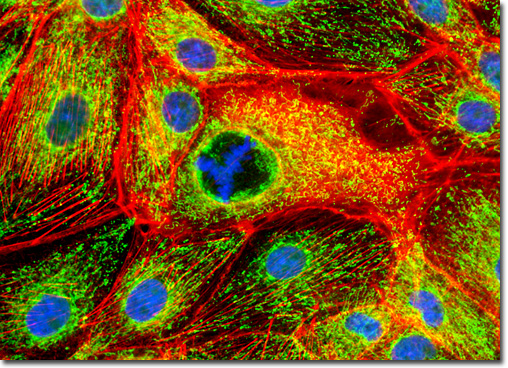Fluorescence Digital Image Gallery
Pig Kidney Epithelial Cells (LLC-PK1)
|
Lectin PNA is a protein derived from peanuts (Arachis hypogaea) that binds to specific carbohydrate groups on proteins or cell membranes. The tetramer is approximately 110 kiloDaltons in size and exhibits specificity for terminal beta-galactose residues of glycoproteins. However, the binding ability of the lectin is inhibited in the presence of lactose. The sites that PNA will bind to in tissues varies, and the lectin has, therefore, been utilized for an array of applications, including detecting acrosome activity in sperm, staining photoreceptors in chick embryos, and labeling colonic mucins in cultures of cancerous tissues. Lectin PNA can also agglutinate human erythrocytes, though only after treatment with neuraminidase. The adherent culture of LLC-PK1 cells displayed in the digital image above was stained for F-actin with Alexa Fluor 568 conjugated to phalloidin, and for DNA with 4',6-diamidino-2-phenylindole (DAPI). The cells were additionally labeled with Oregon Green 488 conjugated to lectin PNA. Images were recorded in grayscale with a QImaging Retiga Fast-EXi camera system coupled to an Olympus BX-51 microscope equipped with bandpass emission fluorescence filter optical blocks provided by Omega Optical. During the processing stage, individual image channels were pseudocolored with RGB values corresponding to each of the fluorophore emission spectral profiles. |
© 1995-2025 by Michael W. Davidson and The Florida State University. All Rights Reserved. No images, graphics, software, scripts, or applets may be reproduced or used in any manner without permission from the copyright holders. Use of this website means you agree to all of the Legal Terms and Conditions set forth by the owners.
This website is maintained by our
|
